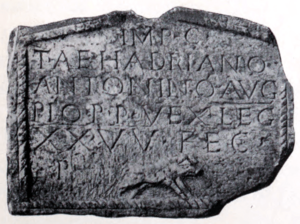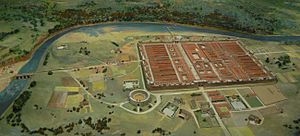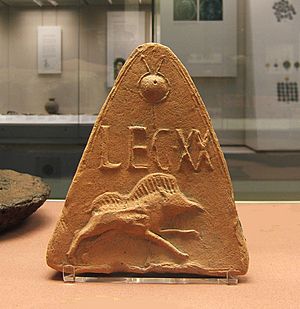Legio XX Valeria Victrix facts for kids

The Legio XX Valeria Victrix was a famous Roman legion. It was like a special army unit in the powerful Imperial Roman army. In English, its name means 'Twentieth Victorious Valeria Legion'.
No one is completely sure how the legion got its full name, Valeria Victrix. One idea is that they earned 'Valeria Victrix' (meaning 'Victorious Valeria') after a big win. This victory happened during the Great Illyrian revolt. Their general, Marcus Valerius Messalla Messallinus, led them to this success. Their special symbol, or emblem, was a boar.
Contents
History of the Twentieth Legion
The Legio XX Valeria Victrix was likely started by Emperor Augustus. This was soon after 31 BC.
Early Campaigns and Movements
This legion probably joined a large Roman army. They fought in the Cantabrian Wars in Hispania (modern-day Spain). These wars took place from 25 to 19 BC.
Around AD 6, the legion moved to Burnum in Illyricum. This was at the start of the Pannonian uprising. They were recorded fighting against the Marcomanni tribe in AD 6. They were part of the army led by Tiberius.
In Illyria, the legion was led by Marcus Valerius Messalla Messallinus. He was the governor of Illyricum. He might have given his family name, Valeria, to the legion. Even though they were not at full strength, they defeated rebels. These rebels were led by Bato of the Daesitiates. In one battle, the legion fought through enemy lines. They were surrounded but managed to fight their way out.
After a big Roman defeat in AD 9, the XX Valeria Victrix moved. They went to Germania Inferior (modern-day Germany). They were based at Oppidum Ubiorum. Later, they moved to Novaesium, which is now Neuss.
Invading Britain
The legion was one of four that Claudius used to invade Britain in AD 43. They helped defeat Caratacus at the Battle of Caer Caradoc. After this, from the AD 50s, they were based at Camulodunum. Some smaller groups were at Kingsholm in Gloucester.
Around AD 55, under Manlius Valens, the legion moved to Usk. They tried to calm the Silures tribe. This tribe in Wales strongly resisted Roman rule. The legion suffered a defeat, and Valens was replaced.
In AD 60 or 61, the Twentieth Legion helped stop the revolt of Queen Boudica. They outflanked the Ordovices tribe. They also took part in the second Roman invasion of Anglesey. This invasion destroyed the Celtic Druids and their religious practices. In AD 66, the legion moved to Viroconium (Wroxeter). This was a much more peaceful area. They might also have been in Gloucester (Glevum) at this time.


Building Walls and Final Years
During the year of the four emperors, the legion supported Vitellius. Some units went with him to Rome. From AD 78 to 84, the legion was part of Gnaeus Julius Agricola's campaigns. These campaigns were in northern Britannia and Caledonia (Scotland). They built a base at Inchtuthill. In AD 88, the legion moved south. They settled at Castra Deva (Deva Victrix), which is now Chester. They stayed there for at least two centuries.
The Twentieth Legion helped build Hadrian's Wall. Stone altars found in Caledonia show their work. This suggests they also helped build the Antonine Wall.
The legion likely went on a campaign in 196 with Decimus Clodius Albinus. They went into Gaul (modern-day France). They probably lost many soldiers there before returning to Britain.
The XX Valeria Victrix was still active during the Carausian Revolt. This revolt created the Britannic Empire in the AD 280s and 290s. We don't have much information about them after this time. Experts believe Legio XX was still in Britain in 407 AD. This is when Constantine III took most of the Roman soldiers from Britain. He needed them for his campaign on the European continent.
Many people have studied this legion. We know the names of at least 250 of its members from old writings.
The Legion in Stories and Media
The Legio XX Valeria Victrix and their last days in Deva (Chester) appear in the novel The Cauldron. This mythic fiction book by Tom Stevens is set in the early AD 400s. The main character, Valerian, defends the city with the legion against pirates. A movie called Victrix! The Valiant of Albion is being made based on this novel.
The Legio XX Valeria Victrix was also featured in the novel Eagle in the Snow. The author, Wallace Breem, suggests they were destroyed in a Germanic invasion in 406.
Several main characters in Jack Whyte's A Dream of Eagles series were once members of Legio XX Valeria Victrix.
Gaius Petreius Ruso is the main character in Medicus by Ruth Downie. He is a military doctor in Britain who works with Legio XX.
The character Valeria Matuchek in Poul Anderson's Operation Chaos and Operation Luna is named after Legio XX. Her mother says this legion was the last to leave Britain.
The story "The Last of the Legions" by Stephen Vincent Benét is told by a senior centurion of the Valeria Victrix. He talks about the legion leaving Britain.
A company in the U.S. Army's 1st battalion, 503rd Infantry Regiment, is named after Legio XX. They are part of the 173rd Airborne Brigade in Vicenza, Italy. They chose this name because paratroopers fight fiercely behind enemy lines.
Legio XX Valeria Victrix appears in the six-novel series Soldier of Rome: The Artorian Chronicles by James Mace.
Legio XX Valeria Victrix is also mentioned in Sir Arthur Conan Doyle’s short story "Through the Veil".
See also
 In Spanish: Legio XX Valeria Victrix para niños
In Spanish: Legio XX Valeria Victrix para niños
- List of Roman legions


